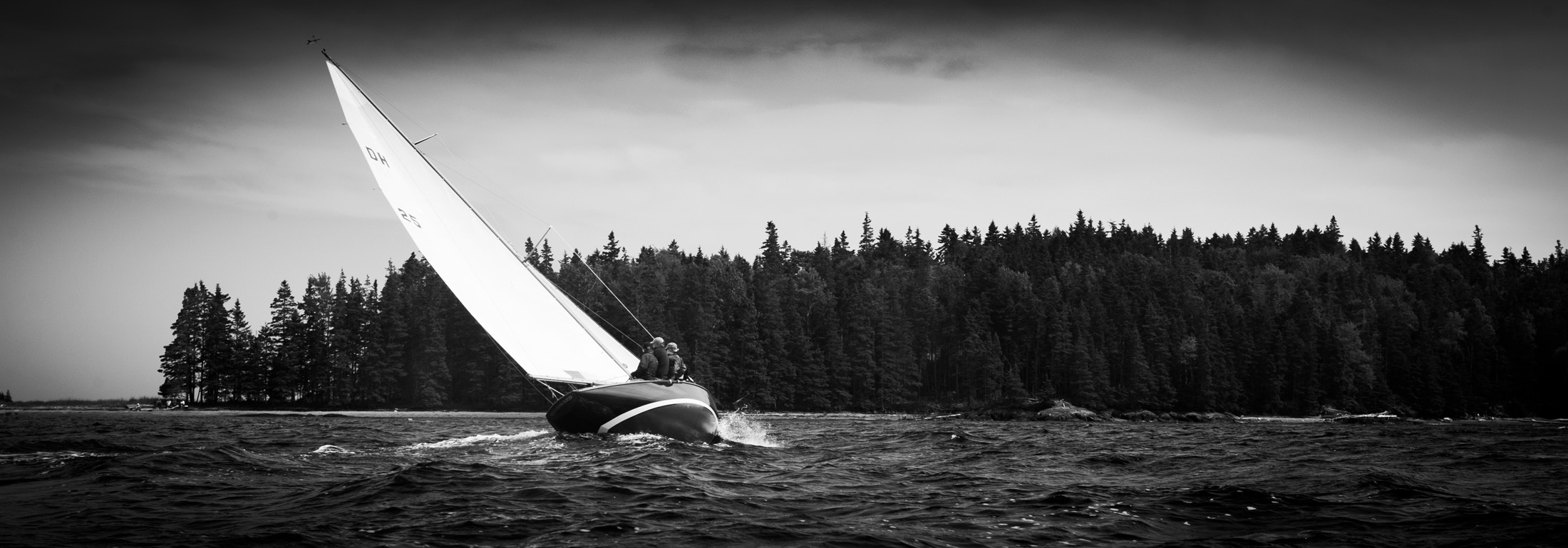
“Dark Harbor 20” Recreation
Sparkman & Stephens of New York, the 75-year-old yacht design firm, is proud to announce the reintroduction of the Dark Harbor 20, the 30-foot one-design class sloop, which is to be constructed for the first time in modern fiberglass materials on a production basis at a very reasonable cost.
LOA 30′-0″ 9.14 m
LWL 20′-0″ 6.10 m
BMAX 6′- 8-1/2″ 2.06 m
Draft 4′-1-1/4″ 1.24 m
Displacement (Lightship) 5,200 lbs 3,360 kg
Ballast 2,620 lbs 1,190 kg
Sail Area (100% fore triangle) 357 ft2 33 m2
Design No. 68
History And Design
In 1932 a committee composed of members of local yacht clubs around Long Island Sound was formed, including members from Seawanhaka, Larchmont and American Yacht Clubs. Their task was to develop a new class of racing sailboat to compete with the Sound Interclub and Atlantic classes. One of the proposals was from Sparkman & Stephens, A Proposed New One- Design Class for Long Island Sound. Hull number one was named Gimcrack, a 34′-6″ LOA, 23’LWL low-profile day sailer very similar in appearance to the Dark Harbor 20. Olin Stephens and the Davidson Laboratory at Stevens Institute successfully used Gimcrack to correlate scale model results with full-scale sailing testing, measuring the longitudinal driving force, aerodynamic side force and heeling moment. The correlation constants between model testing and full-scale performance as derived by these studies became known as the Gimcrack Coefficients. The Gimcrack Coefficients were the first known comparison of this type, proving to be a significant breakthrough in the science of sailing yacht performance prediction. This early trial horse became the genesis of the design of the Dark Harbor 20. In 1934, Olin Stephens took the results from the Gimcrack testing and designed the Dark Harbor 20. She was designed as a fairly fine ended and easily driven hull form, with a simple and straightforward rig. Twenty-one Dark Harbor 20 were built in the first half of the 20th century. Due to the dedication of their owners and the members of the Tarratine Yacht Club of Dark Harbor (Islesboro, Maine), most all of the original DH20’s still exist today and actively compete in the pristine waters of coastal Maine. In a combined effort between the members of the Tarratine Club, Sparkman & Stephens, and Shaw Yacht of Thomaston, Maine, new DH20’s are to be built starting this summer in fiberglass.
Conformity To Originals
In preparation for the design of the fiberglass version of the Dark Harbor 20, Sparkman & Stephens inspected and documented a sampling of the existing Dark Harbor 20 fleet to ascertain the stability and verify the as-built weights of the existing vessels. A series of Dark Harbor 20s were subjected to freeboard measurements (which, when used with the hull lines, can be used to determine the vessel’s weight and longitudinal center of buoyancy), in-the-water inclining experiments (a procedure used to incrementally heel a boat to both port and starboard to access its stability and vertical center of gravity), and on-land scale measurements (to confirm the weight ascertained from freeboard measurements). The fiberglass models have been designed to match the weight and stability of the original fleet so that new boats can race with the existing fleet on an equal basis, preserving the competitive nature of this esteemed one design fleet.
Construction
Shaw Yacht of Thomaston, Maine has been selected as the authorized builder of the new fiberglass Dark Harbor 20s. The production-quality molds of the hull, deck, keel, and rudder are created directly from Sparkman & Stephens 3-dimensional surface models for a high degree of accuracy to the original plans.
The hull, deck, deckhouse, and cockpit are to be built of hand-laid fiberglass over a foam core. The rudder and deadwood will also be built of fiberglass, with the cores of each being poured foam with an adjustable density to accurately match the weights of their original wooden counterparts.
The boats will be finished in gelcoat for a durable, low maintenance finish, with a color of the owner’s choice. The deck surface will have a durable canvas non-skid pattern akin to the originals, achieved by having a permanent texture added to the deck molds. To retain the aesthetics of the original boats, the new boats will have a tasteful amount of wood trim. Woods available will be either teak or mahogany, and either oiled or varnished. The deckhouse and cockpit seating will have vacuum-bagged wooden veneers while the cockpit coamings and toe rails will be solid wood. The spars will be constructed directly from the original plans, and be built of high grade, clear Sitka spruce.
Pricing
Please contact Harry Morgan at Sparkman & Stephens for current pricing and availability.
529 Fifth Avenue, New York NY 10017
(212) 661-6170, fax (212) 661-1235
Email: hmorgan@sparkmanstephens.com
